Strengthening Ecosystem Sustainability and Climate Resilience Through Integrative Nature-Based Solutions in Bontioli Natural Reserve, West African Drylands
Abstract
1. Introduction
2. Literature Review and Conceptual Framework
3. Materials and Methods
3.1. Study Area
3.2. Satellite and Climate Datasets
3.3. Satellite Data Processing
3.4. Vegetation Dynamics and Associated Socio-Environmental Change Pressures
for each i ∈ {LUC class} and t ∈ {2000, 2022}
for each i ∈ {cropland, woodland}
3.5. Ecological Status and Key Specific Threats
3.6. Nature-Based Solution Framework for NBR Sustainability
4. Results
4.1. Vegetation Dynamics and Its Responses to Socio-Environmental Pressure
4.2. Ecological Status with Associated Specific Climate and Anthropogenic Threats
4.3. NbS Options to Enhance the Reserve Resilience and Sustainability
5. Discussion
5.1. NbSs for the Ecosystem Sustainability and Climate Resilience Nexus in BNR
5.2. Opportunities and Constraints of NbS Implementation in Dryland Socio-Ecological Systems
5.3. Limitations and Future Research Direction
6. Conclusions
Supplementary Materials
Author Contributions
Funding
Data Availability Statement
Acknowledgments
Conflicts of Interest
References
- Xu, W.; Xiao, Y.; Zhang, J.; Yang, W.; Zhang, L.; Hull, V.; Wang, Z.; Zheng, H.; Liu, J.; Polasky, S.; et al. Strengthening protected areas for biodiversity and ecosystem services in China. Proc. Natl. Acad. Sci. USA 2017, 114, 1601–1606. [Google Scholar] [CrossRef] [PubMed]
- Adams, W.M.; Small, R.D.S.; Vickery, J.A. The impact of land use change on migrant birds in the Sahel. Biodiversity 2014, 15, 101–108. [Google Scholar] [CrossRef]
- Davies, J. Biodiversity and the Great Green Wall: Managing Nature for Sustainable Development in the Sahel; IUCN: Fontainebleau, France, 2017. [Google Scholar] [CrossRef]
- Martay, B.; Macphie, K.H.; Bowgen, K.M.; Pearce-Higgins, J.W.; Robinson, R.A.; Scott, S.E.; Williams, J.M. Climate Change and Migratory Species: A Review of Impacts, Conservation Actions, Indicators and Ecosystem Services. Part 1—Impacts of Climate Change on Migratory Species; JNCC: Peterborough, UK, 2023; Available online: https://www.cms.int/sites/default/files/publication/Climate%20change%20%26%20migratory%20species%20-%20Part%201.pdf (accessed on 5 May 2015).
- Gudka, M.; Davies, J.; Poulsen, L.; Schulte-Herbrüggen, B.; MacKinnon, K.; Crawhall, N.; Henwood, W.D.; Dudley, N.; Smith, J. Conserving dryland biodiversity: A future vision of sustainable dryland development. Biodiversity 2014, 15, 143–147. [Google Scholar] [CrossRef]
- IPBES-IPCC. IPBES-IPCC Co-Sponsored Workshop Biodiversity and Climate Change Workshop Report. 2021. Available online: https://zenodo.org/records/5101133 (accessed on 8 May 2025).
- United Nations. Synergy Solutions for Climate and SDG Action: Bridging the Ambition Gap for the Future We Want, 2nd ed.; United Nations Department of Economic and Social Affairs & UNFCCC Secretariat: New York, NY, USA, 2024; Available online: https://sdgs.un.org/sites/default/files/2024-07/UN%20Synergy%20Solutions%20for%20Climate%20and%20SDG%20Action-3.pdf (accessed on 11 January 2025).
- Kiribou, R.; Dimobe, K.; Yameogo, L.; Yang, H.; Santika, T.; Dejene, S.W. Two decades of land cover change and anthropogenic pressure around Bontioli Nature Reserve in Burkina Faso. Environ. Chall. 2024, 17, 101025. [Google Scholar] [CrossRef]
- Dimobe, K.; Ouédraogo, A.; Soma, S.; Goetze, D.; Porembski, S.; Thiombiano, A. Identification of driving factors of land degradation and deforestation in the Wildlife Reserve of Bontioli (Burkina Faso, West Africa). Glob. Ecol. Conserv. 2015, 4, 559–571. [Google Scholar] [CrossRef]
- Wang, Z.; Wang, T.; Zhang, X.; Wang, J.; Yang, Y.; Sun, Y.; Guo, X.; Wu, Q.; Nepovimova, E.; Watson, A.E.; et al. Biodiversity conservation in the context of climate change: Facing challenges and management strategies. Sci. Total Environ. 2024, 937, 173377. [Google Scholar] [CrossRef]
- Sankaran, M. Droughts and the ecological future of tropical savanna vegetation. J. Ecol. 2019, 107, 1531–1549. [Google Scholar] [CrossRef]
- Li, F.; Diop, S.; Hirwa, H.; Maesho, S.; Ning, X.; Tian, C.; Qiao, Y.; Faye, C.; Cissé, B.; Guisse, A.; et al. Dryland Social-Ecological Systems in Africa. In Dryland Social-Ecological Systems in Changing Environments; Springer Nature: Singapore, 2024; pp. 273–323. [Google Scholar] [CrossRef]
- Kiribou, I.A.R.; Nikiema, T.; Dimobe, K.; Zoungrana, B.J.B.; Ouedraogo, V.; Yang, H.; Santika, T.; Dejene, S.W. Climate change and variability as drivers of vegetation dynamics in Bontioli Natural Reserve, West African drylands. Environ. Chall. 2025, 20, 101175. [Google Scholar] [CrossRef]
- Sowińska-Świerkosz, B.; García, J. What are Nature-based solutions (NBS)? Setting core ideas for concept clarification. Nat.-Based Solut. 2022, 2, 100009. [Google Scholar] [CrossRef]
- OECD. Nature-Based Solutions for Adapting to Water-Related Climate Risks; OECD: Paris, France, 2020; Available online: https://unfccc.int/sites/default/files/resource/OECD.pdf (accessed on 24 June 2025).
- Mosisa, G.B.; Bedadi, B.; Dalle, G.; Tassie, N. Nature-based solutions for urban climate resilience: Implementation, contribution, and effectiveness. Nat.-Based Solut. 2025, 8, 100245. [Google Scholar] [CrossRef]
- Rodrigues, M.S.; Dias, L.F.; Nunes, J.P. Impact of nature-based solutions on sustainable development goals in Mediterranean agroecosystems: A meta-analysis. J. Environ. Manag. 2024, 371, 123071. [Google Scholar] [CrossRef]
- Lu, Y.; Wang, R.; Zhang, Y.; Su, H.; Wang, P.; Jenkins, A.; Ferrier, R.C.; Bailey, M.; Squire, G.; Lu, Y.; et al. Ecosystem health towards sustainability. Ecosyst. Health Sustain. 2015, 1, 11878976. [Google Scholar] [CrossRef]
- Weiskopf, S.R.; Rubenstein, M.A.; Crozier, L.G.; Gaichas, S.; Griffis, R.; Halofsky, J.E.; Hyde, K.J.W.; Morelli, T.L.; Morisette, J.T.; Muñoz, R.C.; et al. Climate change effects on biodiversity, ecosystems, ecosystem services, and natural resource management in the United States. Sci. Total Environ. 2020, 733, 137782. [Google Scholar] [CrossRef] [PubMed]
- Brockerhoff, E.G.; Barbaro, L.; Castagneyrol, B.; Forrester, D.I.; Gardiner, B.; González-Olabarria, J.R.; Lyver, P.O.B.; Meurisse, N.; Oxbrough, A.; Taki, H.; et al. Forest biodiversity, ecosystem functioning and the provision of ecosystem services. Biodivers. Conserv. 2017, 26, 3005–3035. [Google Scholar] [CrossRef]
- Pires de Souza Araujo, A.C.; Souza dos Santos, D.; Lins-de-Barros, F.; de Souza Hacon, S. Linking ecosystem services and human health in coastal urban planning by DPSIWR framework. Ocean Coast. Manag. 2021, 210, 105728. [Google Scholar] [CrossRef]
- UN. Desertification, Land Degradation and Drought: Sustainable Development Knowledge Platform; United Nations SDG Reports; UN: New York, NY, USA, 2022; Available online: https://sustainabledevelopment.un.org/topics/desertlanddrought/decisions (accessed on 24 June 2025).
- Huang, J.; Li, Y.; Fu, C.; Chen, F.; Fu, Q.; Dai, A.; Shinoda, M.; Ma, Z.; Guo, W.; Li, Z.; et al. Dryland climate change: Recent progress and challenges. Rev. Geophys. 2017, 55, 719–778. [Google Scholar] [CrossRef]
- Cheng, C.; Li, F. Ecosystem restoration and management based on nature-based solutions in China: Research progress and representative practices. Nat.-Based Solut. 2024, 6, 100176. [Google Scholar] [CrossRef]
- Debele, S.E.; Leo, L.S.; Kumar, P.; Sahani, J.; Ommer, J.; Bucchignani, E.; Vranić, S.; Kalas, M.; Amirzada, Z.; Pavlova, I.; et al. Nature-based solutions can help reduce the impact of natural hazards: A global analysis of NBS case studies. Sci. Total Environ. 2023, 902, 165824. [Google Scholar] [CrossRef]
- Port, K.J.N. Nature-based solutions for future earth: Harnessing the power of ecosystems. MOJ Ecol. Environ. Sci. 2023, 8, 218–223. [Google Scholar] [CrossRef]
- Gerstetter, C.; Herb, I.; Matei, A. Mainstreaming Nature-Based Solutions Sustainable Development Goals. 2020. Available online: https://www.ecologic.eu/18248 (accessed on 5 July 2025).
- IUCN. IUCN Global Standard for Nature-Based Solutions: A User-Friendly Framework for the Verification, Design and Scaling Up of NbS, 1st ed.; IUCN: Gland, Switzerland, 2020. [Google Scholar] [CrossRef]
- IUCN. Standard Mondiale de l’UICN pour les Solutions Fondées sur la Nature: Cadre Accessible Pour la Vérification, la Conception et la Mise à L’échelle de Solutions Fondées sur la Nature: Première Edition; IUCN: Gland, Switzerland, 2020. [Google Scholar] [CrossRef]
- IUCN. Nature-based Solutions|IUCN. 2016. Available online: https://www.iucn.org/our-work/nature-based-solutions (accessed on 5 July 2025).
- Cohen-Shacham, E.; Andrade, A.; Dalton, J.; Dudley, N.; Jones, M.; Kumar, C.; Maginnis, S.; Maynard, S.; Nelson, C.R.; Renaud, F.G.; et al. Core principles for successfully implementing and upscaling Nature-based Solutions. In Environmental Science and Policy; Elsevier Ltd.: Amsterdam, The Netherlands, 2019; Volume 98, pp. 20–29. [Google Scholar] [CrossRef]
- IPCC. Climate Change 2022—Impacts, Adaptation and Vulnerability—Summary for Policymakers; 6th Report; IPCC: Geneva, Switzerland, 2022; Available online: https://www.ipcc.ch/ (accessed on 1 July 2025).
- IPCC. Pathways. In Climate Change 2022—Impacts, Adaptation and Vulnerability; IPCC: Geneva, Switzerland, 2023; pp. 2655–2808. [Google Scholar] [CrossRef]
- Mirsafa, M.; Castaldo, A.G.; Lemes de Oliveira, F. Enabling nature-based solutions for climate adaptation in cities of the Global South: Planning dimensions and cross-cutting pathways for implementation. Environ. Dev. Sustain. 2025, 2025, 1–25. [Google Scholar] [CrossRef]
- Naumann, S.; Burgos Cuevas, N.; Davies, C.; Bradley, S.; Mahmoud, I.H.; Arlati, A. Harnessing the Power of Collaboration for Nature-Based Solutions: New Ideas and Insights for Local Decision-Maker; Publications Office of the European Union: Luxembourg, 2023. [Google Scholar]
- Seddon, N.; Daniels, E.; Davis, R.; Chausson, A.; Harris, R.; Hou-Jones, X.; Huq, S.; Kapos, V.; Mace, G.M.; Rizvi, A.R.; et al. Global recognition of the importance of nature-based solutions to the impacts of climate change. Glob. Sustain. 2020, 3, e15. [Google Scholar] [CrossRef]
- Faye, A.; Lejeune, Q.; Sylla, M.B.; Neya, O.; Theokritoff, E.; D’haen, S. Key Points for West Africa from the IPCC Special Report on Climate Change and Land. 2019. Available online: https://climateanalytics.org/publications (accessed on 1 July 2025).
- Walker, B.; Holling, C.S.; Carpenter, S.R.; Kinzig, A. Resilience, Adaptability and Transformability in Social-Ecological Systems. 2004. Available online: http://www.ecologyandsociety.org/vol9/iss2/art5 (accessed on 6 June 2025).
- Qasim, M.; Porembski, S.; Sattler, D.; Stein, K.; Thiombiano, A.; Lindner, A. Vegetation Structure and Carbon Stocks of Two Protected Areas within the South-Sudanian Savannas of Burkina Faso. Environments 2016, 3, 25. [Google Scholar] [CrossRef]
- USGS/NASA. Landsat 8|Landsat Science. 11 September 2023. Available online: https://landsat.gsfc.nasa.gov/satellites/landsat-8/ (accessed on 2 June 2024).
- Roy, D.P.; Kovalskyy, V.; Zhang, H.K.; Vermote, E.F.; Yan, L.; Kumar, S.S.; Egorov, A. Characterization of Landsat-7 to Landsat-8 reflective wavelength and normalized difference vegetation index continuity. Remote Sens. Environ. 2016, 185, 57–70. [Google Scholar] [CrossRef] [PubMed]
- IPBES. Global Assessment Report of the Intergovernmental Science-Policy Platform on Biodiversity and Ecosystem Services; Brondízio, E.S., Settele, J., Díaz, S., Ngo, H.T., Eds.; IPBES Secretariat: Bonn, Germany, 2019; Available online: https://www.ipbes.net/donors (accessed on 5 May 2025).
- Karger, D.N.; Conrad, O.; Böhner, J.; Kawohl, T.; Kreft, H.; Soria-Auza, R.W.; Zimmermann, N.E.; Linder, H.P.; Kessler, M. Climatologies at high resolution for the earth’s land surface areas. Sci. Data 2017, 4, 170122. [Google Scholar] [CrossRef] [PubMed]
- Meinshausen, M.; Nicholls, Z.R.J.; Lewis, J.; Gidden, M.J.; Vogel, E.; Freund, M.; Beyerle, U.; Gessner, C.; Nauels, A.; Bauer, N.; et al. The shared socio-economic pathway (SSP) greenhouse gas concentrations and their extensions to 2500. Geosci. Model Dev. 2020, 13, 3571–3605. [Google Scholar] [CrossRef]
- Arguez, A.; Vose, R.S. The Definition of the Standard WMO Climate Normal: The Key to Deriving Alternative Climate Normals. Bull. Am. Meteorol. Soc. 2011, 92, 699–704. [Google Scholar] [CrossRef]
- CIESIN. Documentation for Gridded Population of the World: Revision Version 11 Data Sets; CIESIN: Palisades, NY, USA, 2018. [Google Scholar] [CrossRef]
- World Pop. School of Geography and Environmental Science, University of Southampton; Department of Geography and Geosciences, University of Louisville; Departement de Geographie, Universite de Namur) and Center for International Earth Science Information Network (CIESIN), Columbia University (2018). Global High Resolution Population Denominators Project—Funded by The Bill and Melinda Gates Foundation (OPP1134076). 22 June 2020. Available online: https://hub.worldpop.org/doi/10.5258/SOTON/WP00674 (accessed on 22 June 2025).
- Granata, D.; Palombo, A.; Santini, F.; Amato, U. Noise removal from remote sensed images by non local means with OpenCL algorithm. Remote Sens. 2020, 12, 414. [Google Scholar] [CrossRef]
- Karlsen, S.; Elvebakk, A.; Høgda, K.; Grydeland, T. Spatial and Temporal Variability in the Onset of the Growing Season on Svalbard, Arctic Norway—Measured by MODIS-NDVI Satellite Data. Remote Sens. 2014, 6, 8088–8106. [Google Scholar] [CrossRef]
- Liu, D.; Jia, K.; Jiang, H.; Xia, M.; Tao, G.; Wang, B.; Chen, Z.; Yuan, B.; Li, J. Fractional Vegetation Cover Estimation Algorithm for FY-3B Reflectance Data Based on Random Forest Regression Method. Remote Sens. 2021, 13, 2165. [Google Scholar] [CrossRef]
- Zhang, S.; Chen, H.; Fu, Y.; Niu, H.; Yang, Y.; Zhang, B. Fractional Vegetation Cover Estimation of Different Vegetation Types in the Qaidam Basin. Sustainability 2019, 11, 864. [Google Scholar] [CrossRef]
- IPCC. Policymakers. In Climate Change 2021: The Physical Science Basis. Contribution of Working Group I to the Sixth Assessment Report of the Intergovernmental Panel on Climate Change; Masson-Delmotte, V., Zhai, P., Pirani, A., Connors, S.L., Péan, C., Berger, S., Caud, N., Chen, Y., Goldfarb, L., Gomis, M.I., et al., Eds.; Cambridge University Press: Cambridge, UK, 2021. [Google Scholar] [CrossRef]
- Aubreville, A. Agreement at Yangambi on the Nomenclature of African Vegetation Types. 1957. Available online: https://www.cabidigitallibrary.org/doi/full/10.5555/19570602656 (accessed on 3 February 2024).
- Wood, S.N.; Pya, N.; Säfken, B. Smoothing Parameter and Model Selection for General Smooth Models. J. Am. Stat. Assoc. 2016, 111, 1548–1563. [Google Scholar] [CrossRef]
- R Core Team. R: The R Project for Statistical Computing. Internet. 2023. Available online: https://www.r-project.org/ (accessed on 4 December 2024).
- Guisan, A.; Edwards, T.C.; Hastie, T. Generalized linear and generalized additive models in studies of species distributions: Setting the scene. Ecol. Model. 2002, 157, 89–100. [Google Scholar] [CrossRef]
- IUCN. IUCN Red List of Threatened Species; IUCN: Gland, Switzerland, 2025; Available online: https://www.iucnredlist.org/ (accessed on 22 December 2024).
- Key, I.B.; Smith, A.C.; Turner, B.; Chausson, A.; Girardin, C.A.J.; Macgillivray, M.; Seddon, N. Biodiversity outcomes of nature-based solutions for climate change adaptation: Characterising the evidence base. Front. Environ. Sci. 2022, 10, 905767. [Google Scholar] [CrossRef]
- Luo, Q.; Li, S.; Wang, H.; Cheng, H. Mapping Human Pressure for Nature Conservation: A Review. Remote Sens. 2024, 16, 3866. [Google Scholar] [CrossRef]
- Huggins, C.; Bishwajit, G. Enabling Conditions for Nature-based Solutions for Climate Adaptation in the Guinean Forests of West Africa: Evidence From Côte d’Ivoire, Ghana, and Guinea. J. Environ. Dev. 2025, 10704965251317450. [Google Scholar] [CrossRef]
- Kassa, H.; Abiyu, A.; Hagazi, N.; Mokria, M.; Kassawmar, T.; Gitz, V. Forest landscape restoration in Ethiopia: Progress and challenges. Front. For. Glob. Change 2022, 5, 796106. [Google Scholar] [CrossRef]
- Brownson, K.; Anderson, E.P.; Ferreira, S.; Wenger, S.; Fowler, L.; German, L. Governance of Payments for Ecosystem Ecosystem services influences social and environmental outcomes in Costa Rica. Ecological Economics 2020, 174, 106659. [Google Scholar] [CrossRef]
- Naidoo, R.; Weaver, L.C.; De Longcamp, M.; Du Plessis, P. Namibia’s community-based natural resource management programme: An unrecognized payments for ecosystem services scheme. Environ. Conserv. 2011, 38, 445–453. [Google Scholar] [CrossRef]
- Gadzama, N.M. Attenuation of the effects of desertification through sustainable development of Great Green Wall in the Sahel of Africa. World J. Sci. Technol. Sustain. Dev. 2017, 14, 279–289. [Google Scholar] [CrossRef]
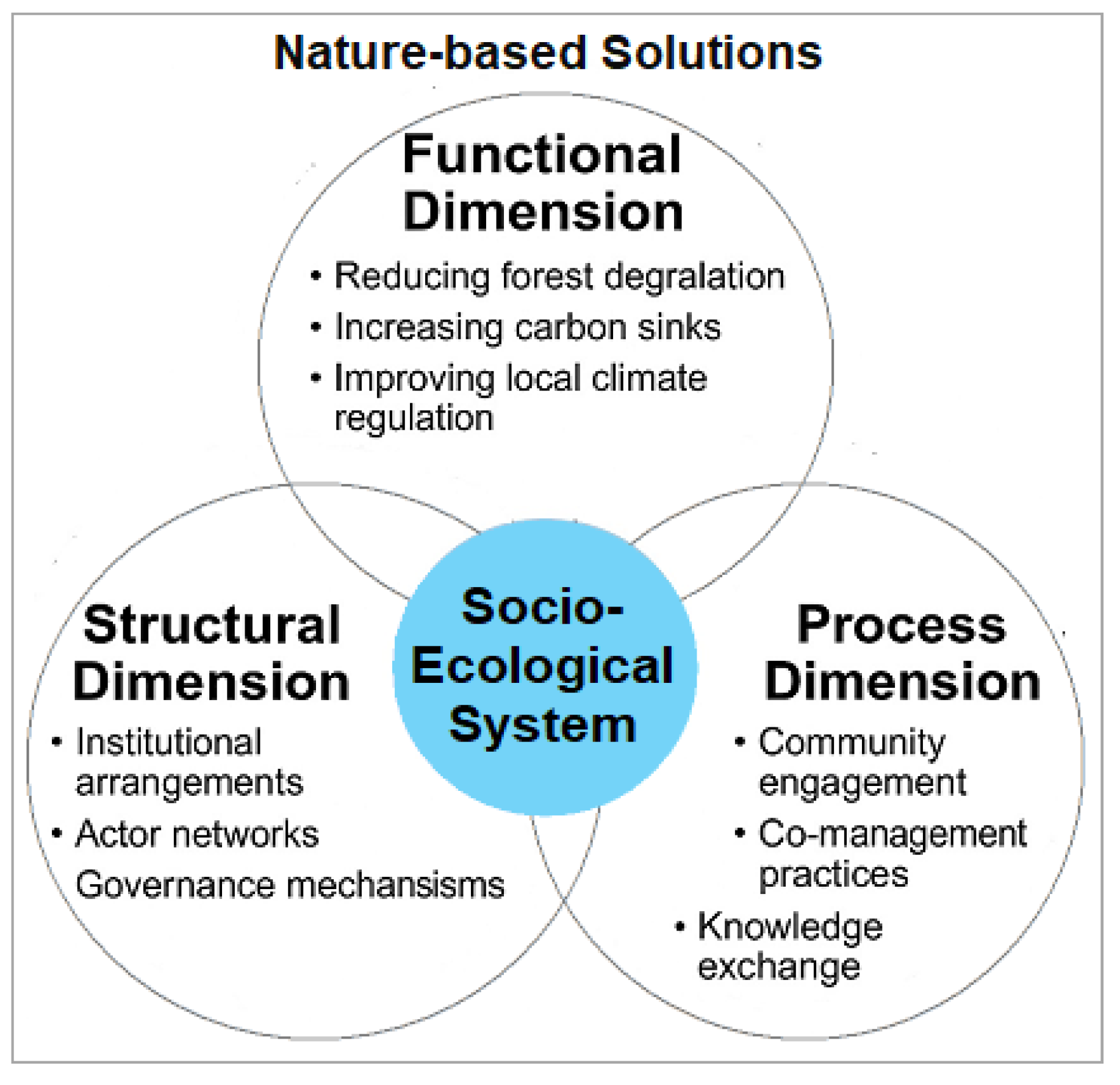
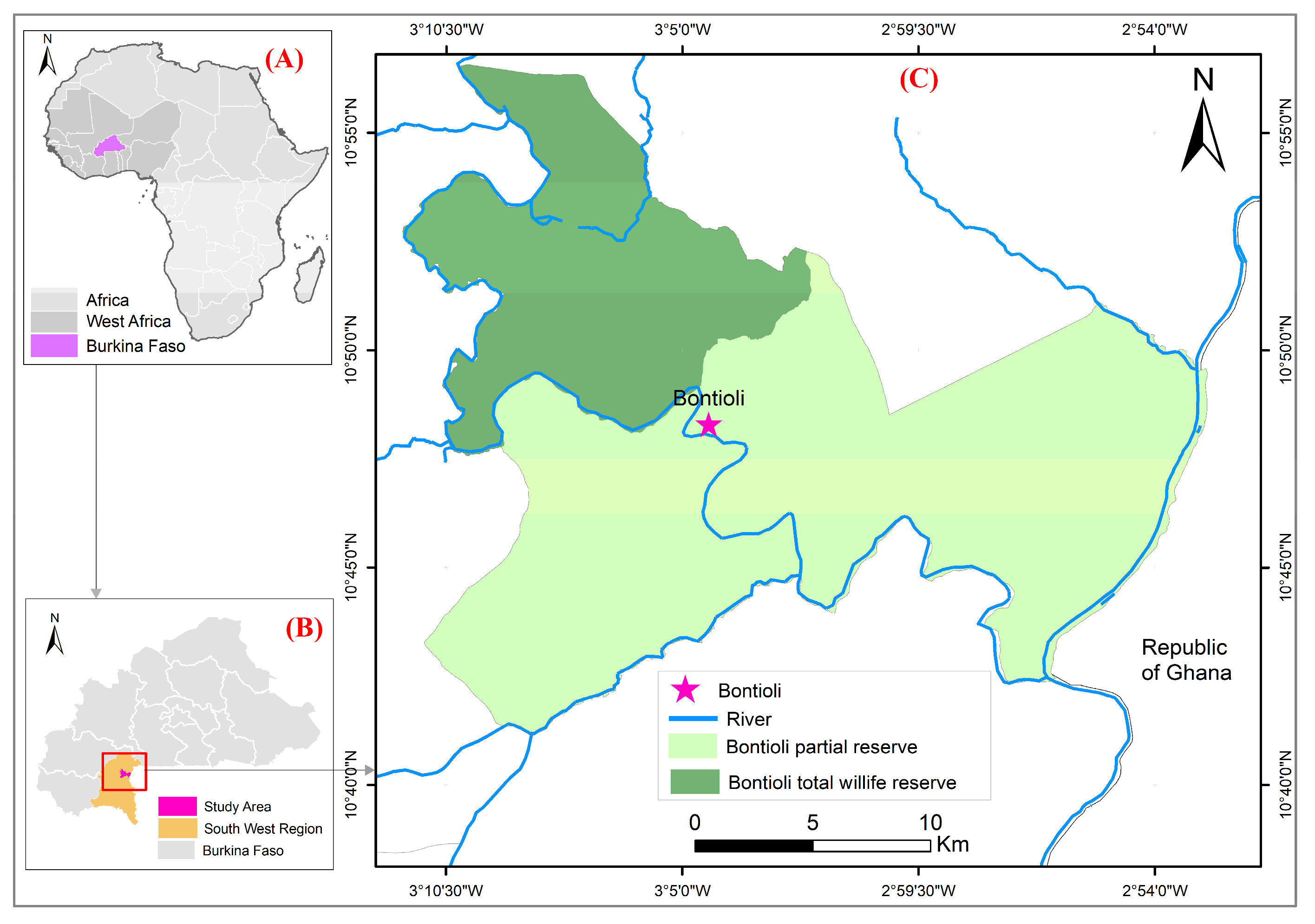

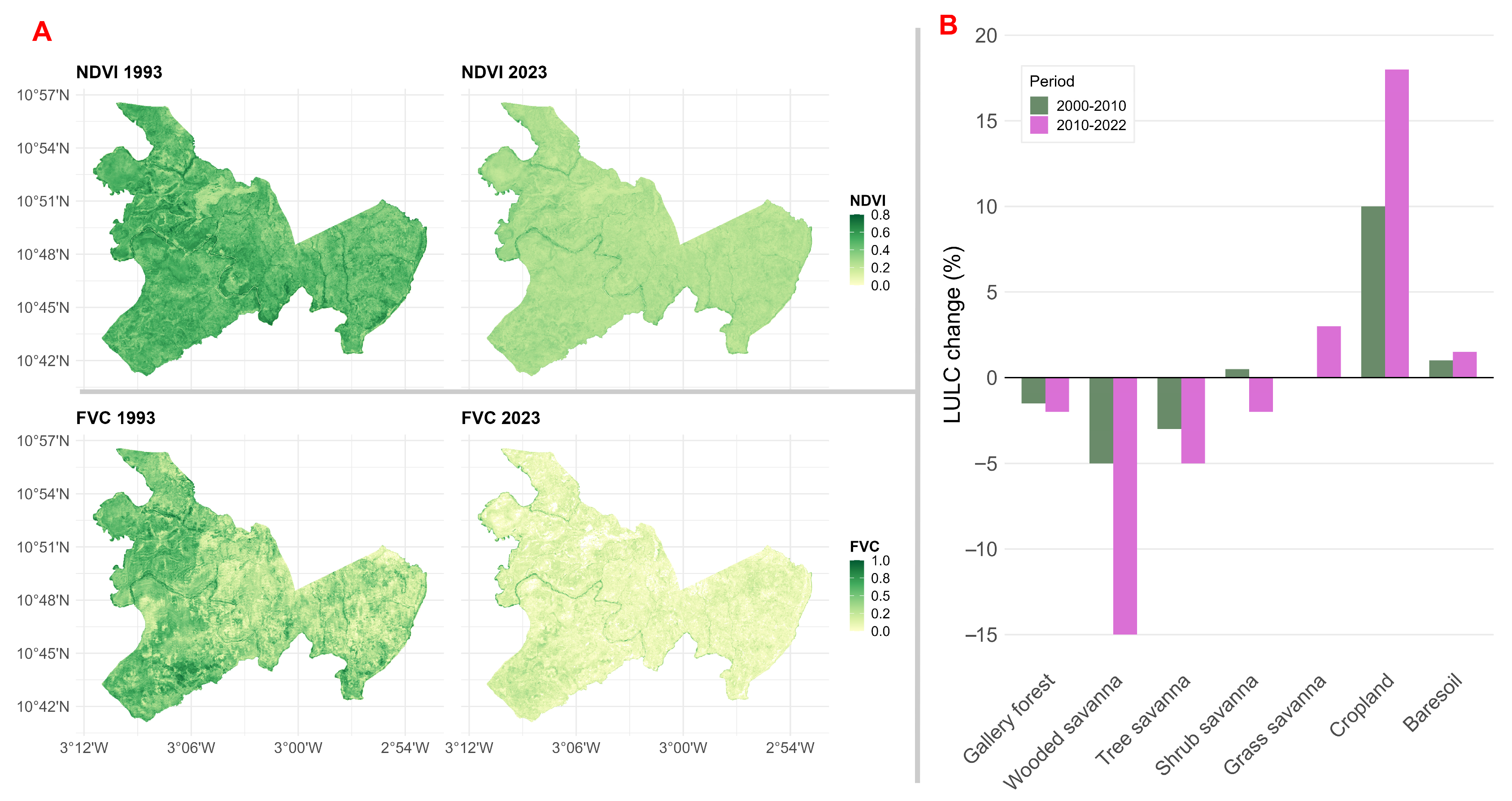
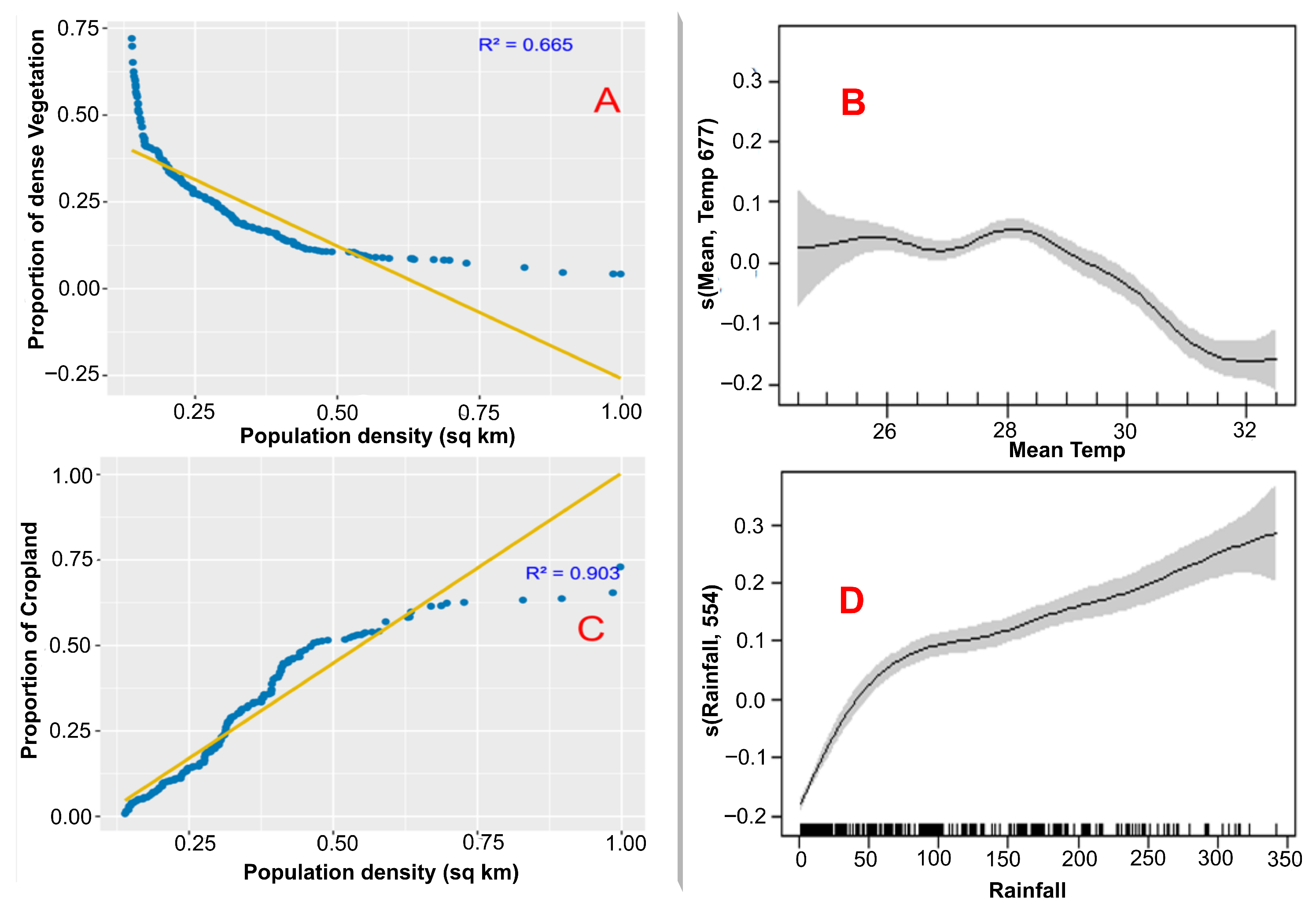
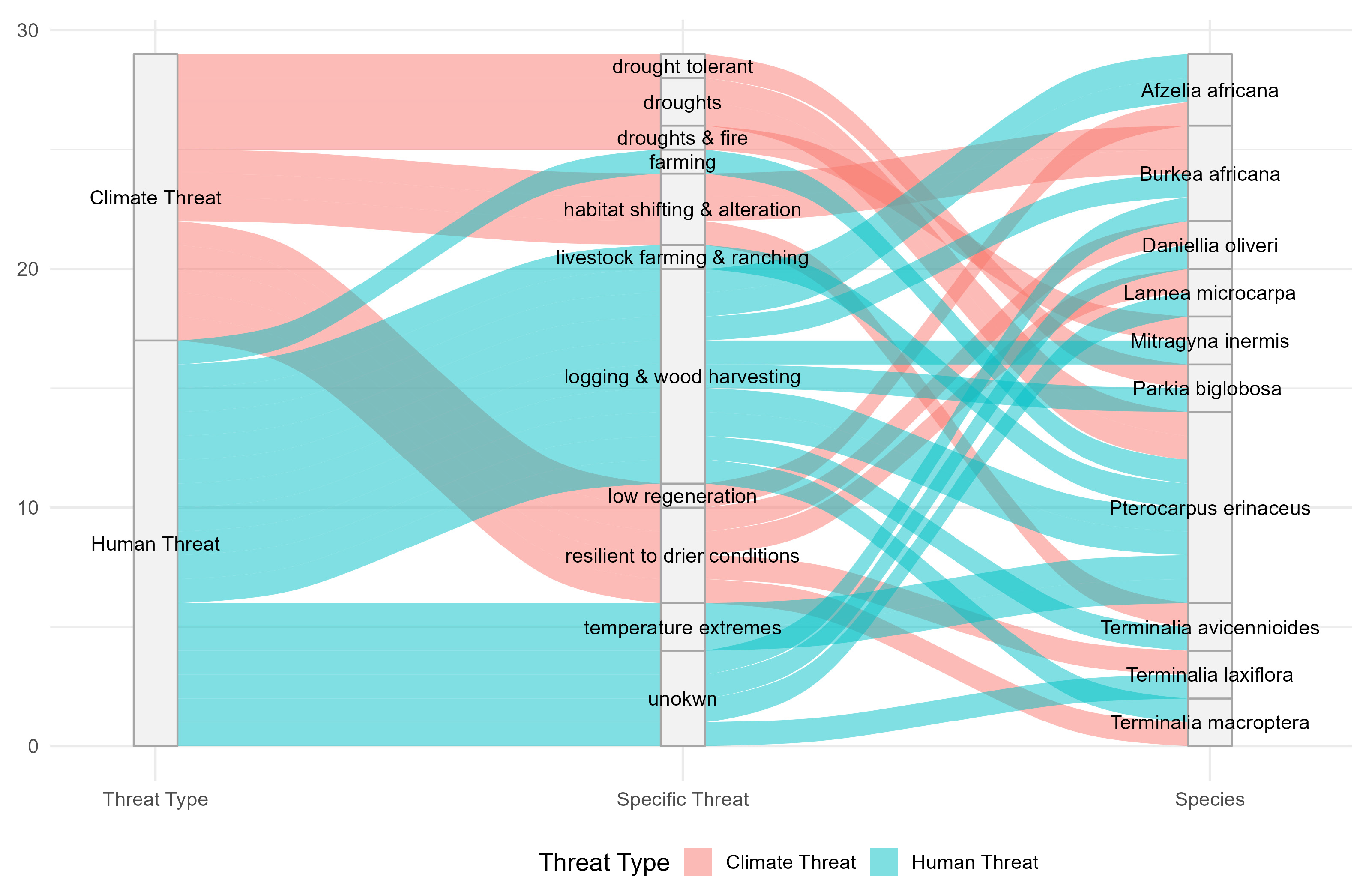
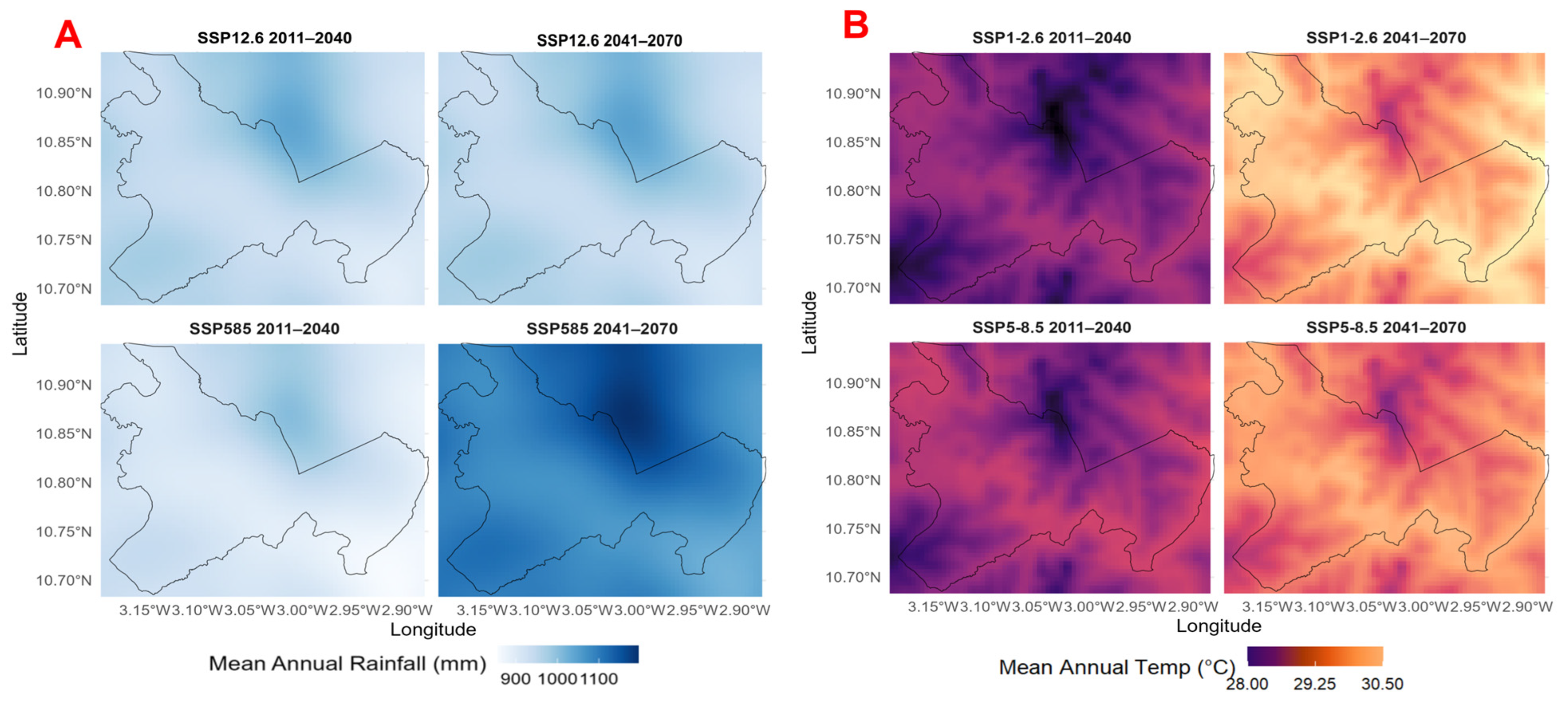
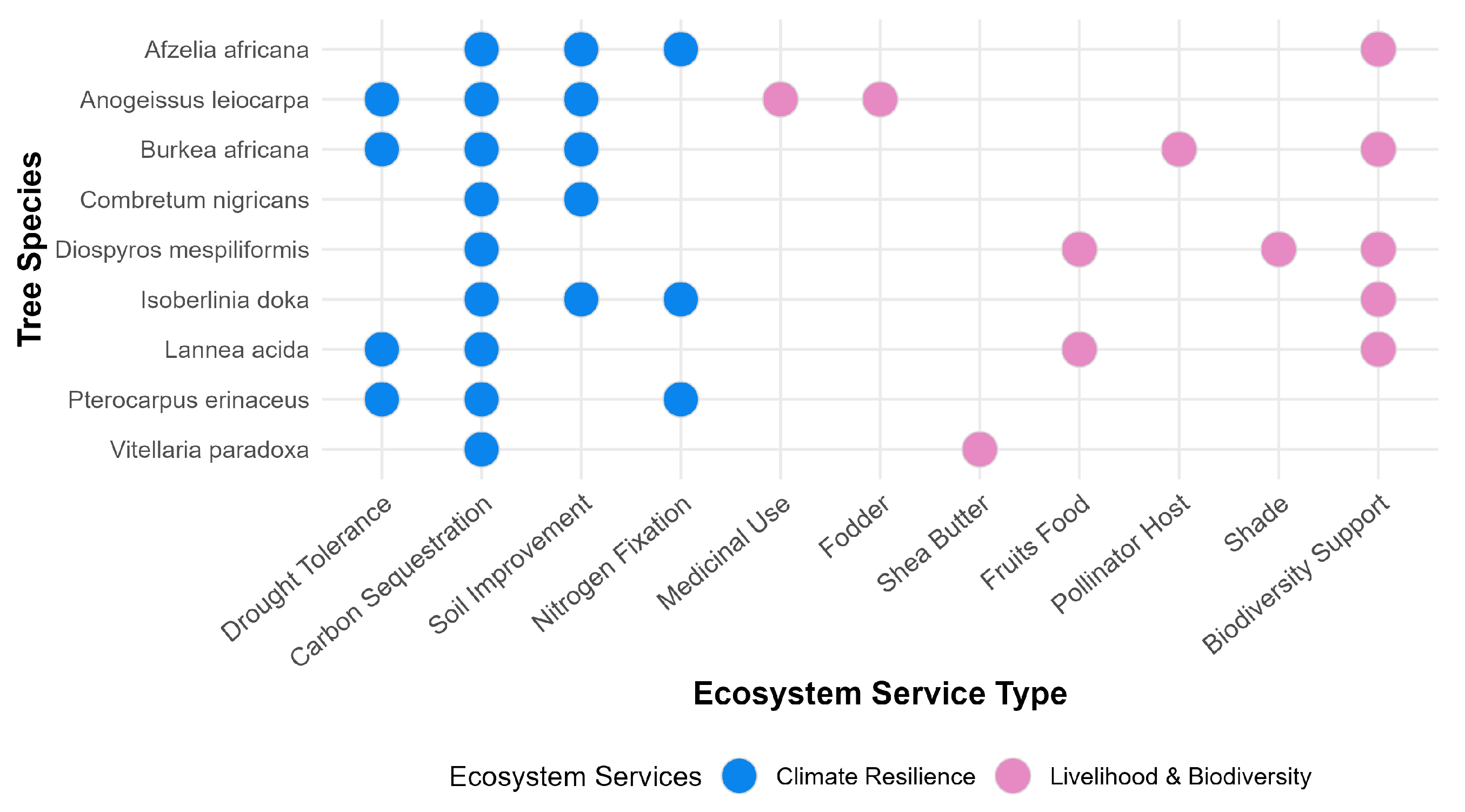
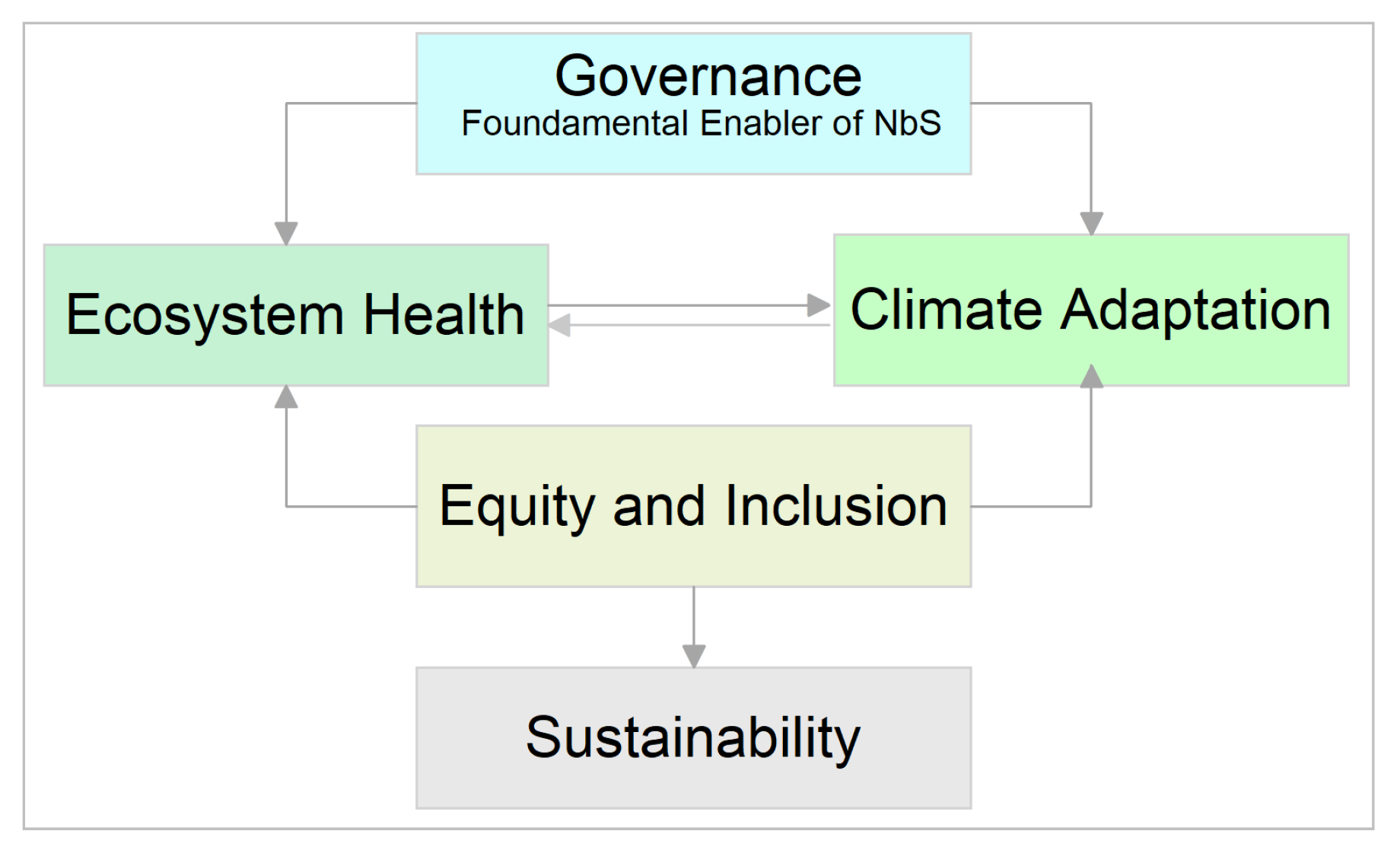
| Data Type | Data Item | Spatial/Temporal Resolution | Image’s Variables | Dates | Sources |
|---|---|---|---|---|---|
| Satellite data | Landsat ETM | 30 m/16 days | Bands 3, 4 | January 1993 to December 2000 | https://www.usgs.gov/landsat-missions/landsat-collection-2-level-2-science-products (accessed on 18 February 2025) |
| Landsat ETM+ | 30 m/16 days | Bands 3, 4 | January 2001 to December 2013 | ||
| Landsat OLI-TIRS | 30 m/16 days | Bands 4, 5 | January 2014 to December 2023 | ||
| SRTM | 30 m | 1 | Since 2000 | https://glovis.usgs.gov/app (accessed on 2 February 2025) | |
| Climate variables | Monthly Rainfall | 30 days/900 m | Rainfall | January 1993 to December 2023 | https://chelsa-climate.org/downloads/ (accessed on 27 December 2024) |
| Monthly Temperature | 30 days/900 m | Temperature | January 1993 to December 2023 | ||
| Population data | Population Density | ~1 km2 | Population density | 2000 | https://hub.worldpop.org/geodata/summary?id=44536 (accessed on 27 January 2024) |
| Aspect | Data/Tool | Purpose |
|---|---|---|
| Climate Exposure | Future climate projections (e.g., WorldClim CMIP6, CHELSA), | Identify areas most affected by temperature or rainfall shifts |
| Ecological Sensitivity | Species status (IUCN), land cover trends. | Find areas with fragile biodiversity |
| Anthropogenic Pressure | Land use changes, fire history, proximity to roads/settlements | Map human impact zones (LULC map) |
| Goal | Target | Instrument | Outcome | Risk | SDG |
|---|---|---|---|---|---|
| Ecosystem Health | Regreen degraded areas | Native species planting, drought-tolerant species, regenerative grazing | NDVI and FVC increase % (vegetation cover) | Accelerated desertification (% NDVI and FVC decrease) | SDG 13 (Climate), SDG 15 (Life on Land) |
| Equity Inclusion | Boost livelihoods | Ecotourism, Community grants, value chains for dryland crops, women-led cooperatives | Income levels, % local employment | Displacement, increased inequality | SDG 1 (Poverty), SDG 5 (Gender), SDG 8 (Decent Work) |
| Governance | Decentralize and sensitize NbS policies | Local land-use committees, land tenure, and participatory monitoring of NbS implementation | % of co-managed zones | Land conflicts, lack of trust | SDG 16 (Institutions), SDG 17 (Partnerships) |
| Climate Adaptation | Drought and erosion resilience | Regreen Gallery forest, Soil restoration, early warning systems | Water retention index, Soil erosion index | Increased climate risk and Soil erosion | SDG 6 (Water), SDG 13 (Climate Action) |
Disclaimer/Publisher’s Note: The statements, opinions and data contained in all publications are solely those of the individual author(s) and contributor(s) and not of MDPI and/or the editor(s). MDPI and/or the editor(s) disclaim responsibility for any injury to people or property resulting from any ideas, methods, instructions or products referred to in the content. |
© 2025 by the authors. Licensee MDPI, Basel, Switzerland. This article is an open access article distributed under the terms and conditions of the Creative Commons Attribution (CC BY) license (https://creativecommons.org/licenses/by/4.0/).
Share and Cite
Kiribou, I.A.R.; Dimobe, K.; Dejene, S.W. Strengthening Ecosystem Sustainability and Climate Resilience Through Integrative Nature-Based Solutions in Bontioli Natural Reserve, West African Drylands. Earth 2025, 6, 111. https://doi.org/10.3390/earth6030111
Kiribou IAR, Dimobe K, Dejene SW. Strengthening Ecosystem Sustainability and Climate Resilience Through Integrative Nature-Based Solutions in Bontioli Natural Reserve, West African Drylands. Earth. 2025; 6(3):111. https://doi.org/10.3390/earth6030111
Chicago/Turabian StyleKiribou, Issaka Abdou Razakou, Kangbéni Dimobe, and Sintayehu W. Dejene. 2025. "Strengthening Ecosystem Sustainability and Climate Resilience Through Integrative Nature-Based Solutions in Bontioli Natural Reserve, West African Drylands" Earth 6, no. 3: 111. https://doi.org/10.3390/earth6030111
APA StyleKiribou, I. A. R., Dimobe, K., & Dejene, S. W. (2025). Strengthening Ecosystem Sustainability and Climate Resilience Through Integrative Nature-Based Solutions in Bontioli Natural Reserve, West African Drylands. Earth, 6(3), 111. https://doi.org/10.3390/earth6030111






